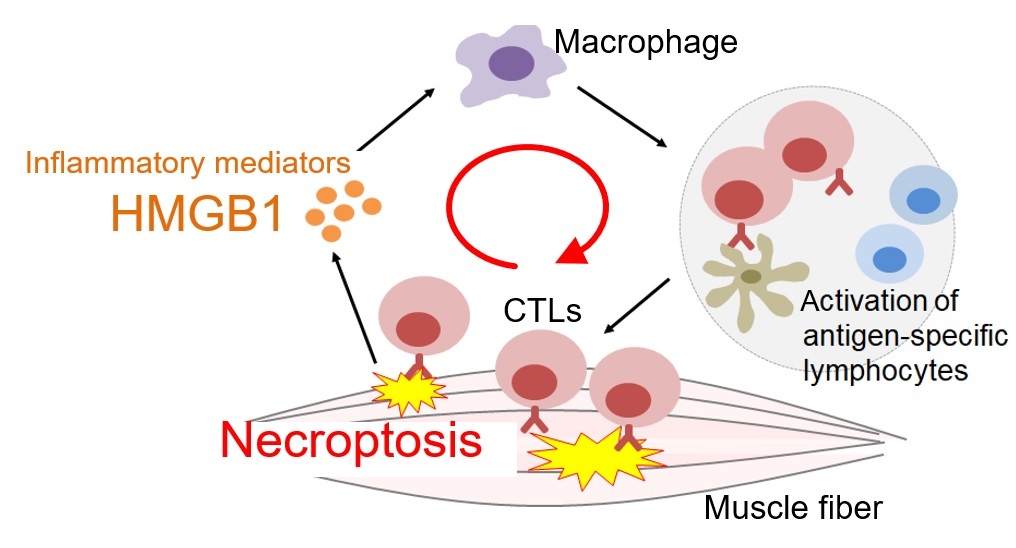Targeting Necroptosis for Inflammatory Myopathies
Published: January 10, 2022
A new study has suggested that treatment to target necroptosis in muscle fibers using a necroptosis inhibitor lessens myositis-induced muscle weakness as well as muscle cell death and inflammation in the muscles. This has been shown to be a promising strategy for treating polymyositis.
Polymyositis (PM) is a chronic inflammatory myopathy wherein muscle weakness is the most common symptom, leading to progressive and persistent disability. Its pathophysiology is assumingly the injury of muscle fibers by autoaggresive cytotoxic T lymphocytes (CTLs). Current treatments of PM depend on nonspecific immunosuppressants including glucocorticoids and immunosuppressive agents. However, some patients fail to respond to the immunosuppressive therapies, and some also suffer from infectious diseases during the treatment. In addition, muscle weakness persists in more than half of the patients despite reduction in muscle inflammation.
It is clear that a better therapeutic strategy that not only suppresses muscle inflammation but also prevents muscle weakness and at the same time avoiding an increasing risk of infection is needed.
The study hypothesized that the injured muscle fibers in PM release pro-inflammatory molecules, and that the inhibition of the cell death of muscle fibers could be a novel therapeutic strategy to suppress both muscle injury and inflammation.
Polymyositis (PM) is a chronic inflammatory myopathy wherein muscle weakness is the most common symptom, leading to progressive and persistent disability. Its pathophysiology is assumingly the injury of muscle fibers by autoaggresive cytotoxic T lymphocytes (CTLs). Current treatments of PM depend on nonspecific immunosuppressants including glucocorticoids and immunosuppressive agents. However, some patients fail to respond to the immunosuppressive therapies, and some also suffer from infectious diseases during the treatment. In addition, muscle weakness persists in more than half of the patients despite reduction in muscle inflammation.
It is clear that a better therapeutic strategy that not only suppresses muscle inflammation but also prevents muscle weakness and at the same time avoiding an increasing risk of infection is needed.
The study hypothesized that the injured muscle fibers in PM release pro-inflammatory molecules, and that the inhibition of the cell death of muscle fibers could be a novel therapeutic strategy to suppress both muscle injury and inflammation.

Visual abstract
Muscle fiber necroptosis and subsequent release of HMGB1 aggravate inflammation in PM.
The study found that the pattern of cell death in muscle fibers is necroptosis. This was done using an integrative analysis including histological imaging of human muscle biopsy samples from PM/DM patients and functional studies with models of PM. The injured muscle fibers undergo necroptosis and release high levels of HMGB1 which lead to further acceleration of muscle inflammation and subsequent muscle injury in PM. This indicates that muscle cells are not merely passive responders, but rather are aggressors that actively promote muscle inflammation in PM.
In the treatment of PM, it is important to promote muscle regeneration to help recover from muscle weakness in addition to the suppression of muscle injuries by CTLs. A speedy improvement in this was actually observed during treatment which suggests an improvement of muscle fiber functions due to the inhibition of necroptosis. HMGB1 acts as a potent regenerative factor in muscles and so therefore the long-term blocking of HMGB1 in the chronic phase of the disease seems to interfere with muscle strength in PM patients. Considering the therapeutic effect of necroptosis inhibition to suppress muscle fiber death and subsequent release of HMGB1, inhibition of necroptosis may be seen as providing a good therapeutic option in the acute phase of the disease.
Inflammatory myopathies are systemic diseases which can affect the skin, lung, heart, joint, and gastro-intestinal tract. Given the involvement of necroptosis in inflammatory diseases of various organs and the efficacy of necroptosis inhibitions in corresponding animal models such as dermatitis, acute respiratory distress syndrome, cardio myositis, arthritis, and colitis, systemic inhibition of necroptosis could also be a potential therapy for the extra muscular involvement of inflammatory myopathies.
Conclusively, inhibition of necroptosis in muscle fibers would be a novel therapeutic strategy to recover muscle strength through suppressing muscle cell death and inflammation in PM. Since this type of muscle cell-directed therapy does not directly suppress immune cells or inflammatory mediators, it is a promising alternative to current immunosuppressive therapies for PM with potentially less infectious complications.
Clinical trials to test the therapeutic and side effects of necroptosis inhibition are awaited in PM, given the promising therapeutic effects in these pre-clinical studies.
Inflammatory myopathies are systemic diseases which can affect the skin, lung, heart, joint, and gastro-intestinal tract. Given the involvement of necroptosis in inflammatory diseases of various organs and the efficacy of necroptosis inhibitions in corresponding animal models such as dermatitis, acute respiratory distress syndrome, cardio myositis, arthritis, and colitis, systemic inhibition of necroptosis could also be a potential therapy for the extra muscular involvement of inflammatory myopathies.
Conclusively, inhibition of necroptosis in muscle fibers would be a novel therapeutic strategy to recover muscle strength through suppressing muscle cell death and inflammation in PM. Since this type of muscle cell-directed therapy does not directly suppress immune cells or inflammatory mediators, it is a promising alternative to current immunosuppressive therapies for PM with potentially less infectious complications.
Clinical trials to test the therapeutic and side effects of necroptosis inhibition are awaited in PM, given the promising therapeutic effects in these pre-clinical studies.
Summary
A new study targeting necroptosis in muscle fibers offers new hope for the treatment of inflammatory myopathy.
Journal Article
JOURNAL: Nature Communications
TITLE:Targeting necroptosis in muscle fibers ameliorates inflammatory myopathies
DOI:https://doi.org/10.1038/s41467-021-27875-4
TITLE:Targeting necroptosis in muscle fibers ameliorates inflammatory myopathies
DOI:https://doi.org/10.1038/s41467-021-27875-4

